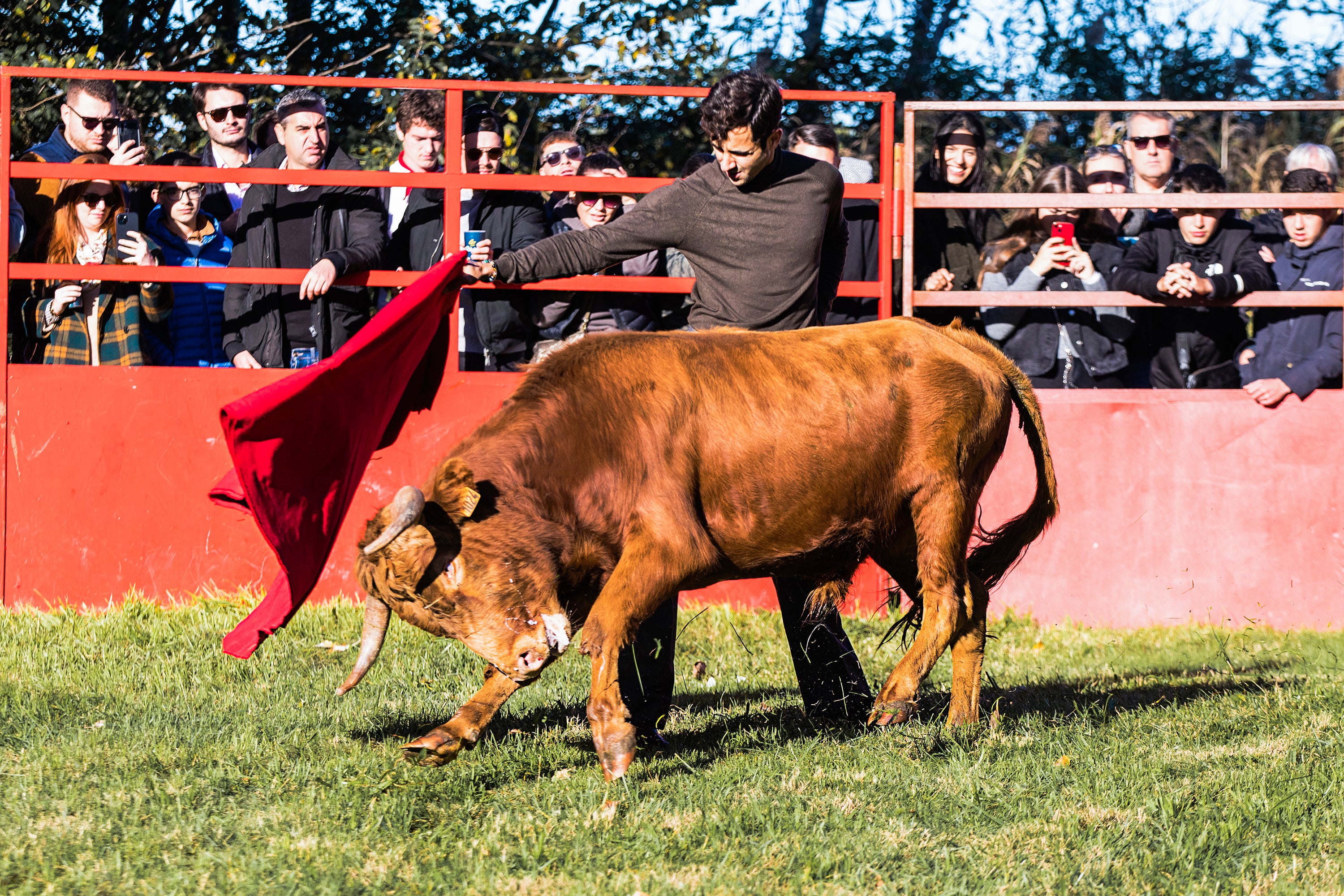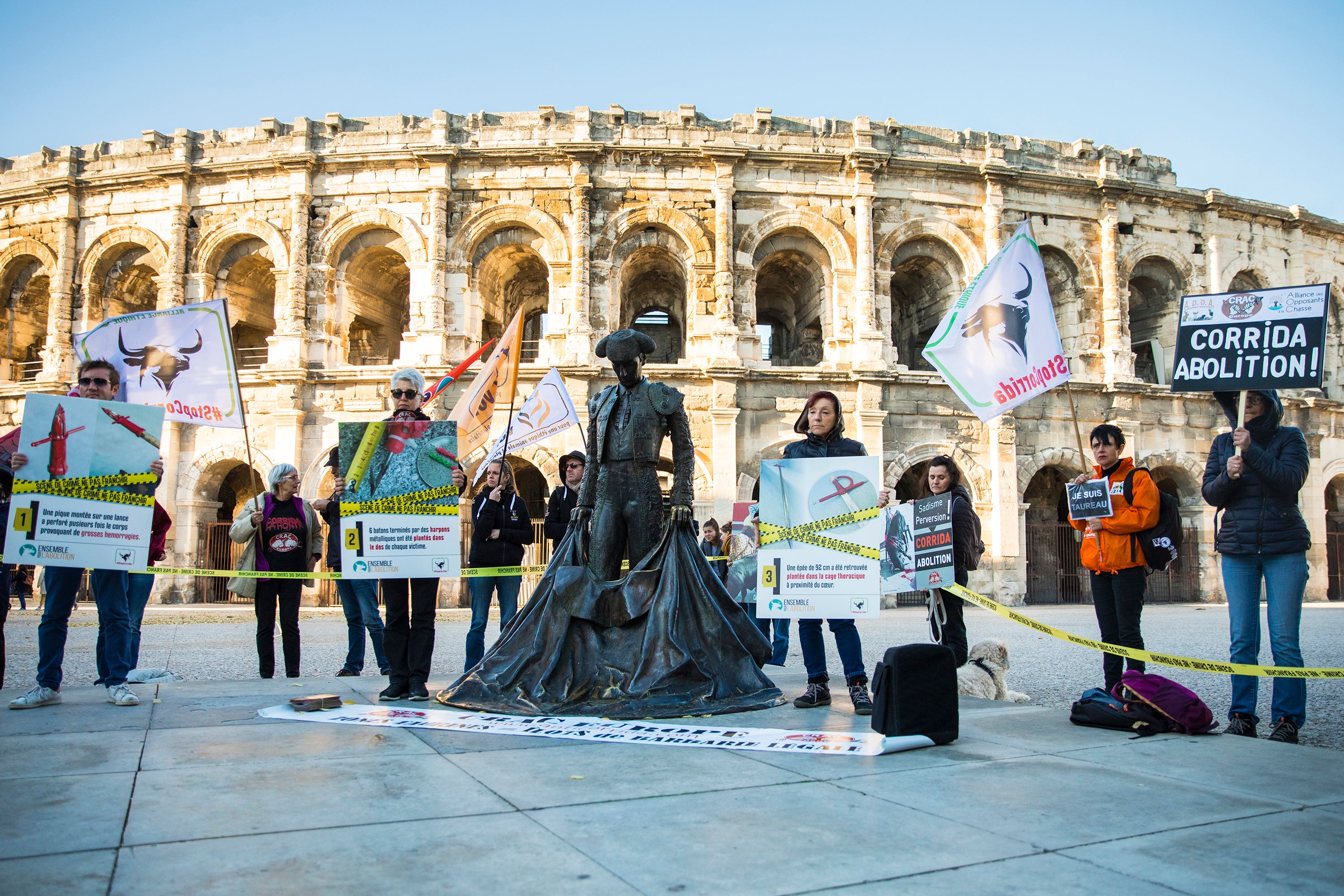Southern France may be the last bastion of bullfighting
Much to the alarm of animal rights activists, bullfighting is enjoying an unlikely surge in popularity in France’s south. Rick Noack speaks to those for and against the bloodsport

The sound of horns clanging against a metal enclosure can be heard as hundreds of spectators arrive at a makeshift arena in a pine grove.
While adults indulge in bottles of wine, children bounce across an inflatable amphitheatre on a plastic bull with blood-red eyes. Soon, Charles Pasquier will face off against a real bull. But the 26-year-old bullfighter appears relaxed as he works the crowd before the contest.
Ten years ago, an event like this wouldn’t have attracted many people his age, he says. But now, “an enormous amount of young people are returning. There’s a wave of renewal.”
Although these kinds of spectacles are in retreat in Spain and in Latin America, and although polls show as many as 77 per cent of people in France want an end to bullfights, the sport is seeing a surge of popularity in southern France.
Last Thursday, the French National Assembly was for the first time expected to vote on a proposed ban. But after opponents of a prohibition moved to obstruct the vote with a wave of amendments, the far-left lawmaker who had proposed the ban withdrew his draft law.
While the withdrawal does not rule out a vote in the coming months, even some animal rights groups admit the chances of a win will be slim, as politicians across the political spectrum fear a rural voter backlash.
Backed by members of French president Emmanuel Macron’s party, a parliamentary law commission recommended against a ban last week. “What will be the next regional tradition that we will outlaw?” Marie Lebec, a lawmaker from Macron’s party, asked during the initial debate.
On Wednesday, Macron suggested to an audience of mayors that there wouldn’t be a ban anytime soon. “We must move toward a conciliation, an exchange,” he said. “From where I stand, it’s not the priority at the moment. This subject must progress with respect and consideration.”
Up for debate was whether France’s animal welfare law should have been amended to get rid of exemptions for bullfighting and cockfighting in places where they are “uninterrupted local traditions.”

Critics question the notion of bullfighting as inherently French. Although the oldest record of bull running in France is from 1289, the bloody Spanish-style corrida, they note, was imported for the benefit of the Spanish-born wife of Napoleon III in the 19th century.
For a time, the contests prospered across France, with major bullrings erected in the Parisian Bois de Boulogne park and in other cities. But it is only in southern France, near the border with Spain and along the Mediterranean, that bullfighting continues today, drawing about two million spectators each year, according to the National Observatory of Bullfighting Cultures.
Animal rights activists argue that the practice has no place anywhere in modern times. They say the bulls die slowly and painfully, repeatedly stabbed in the neck and shoulders. Between 800 and 1,000 bulls are killed in French contests each year.
Nathalie Valentin, 56, says the one time she attended a bullfight, she was so shocked she ran out of the arena. “After every stab, the bull reared. It was horrible,” she says. “I didn’t understand why people had come to watch it.”

But Valentin is in the minority of people willing to speak out against the practice in her hometown of Nîmes, France’s de facto bullfighting capital. When activists organised anti-bullfighting demonstrations across the country last weekend, fewer than 50 people showed up outside the city’s Roman amphitheatre, where the local bullfights take place. The activists struggled to attract the attention of pedestrians as they held aloft posters of dead bulls. Their speeches were at times drowned out by a motorcyclist who deliberately revved his engine.
Earlier in the day, a pro-bullfighting demonstration a few blocks away had drawn about eight times more people. In many towns, the rallies in favour were organised or attended by mayors, suggesting broad public support.
The mayor of Mont-de-Marsan, Charles Dayot, complained to AFP that the far-left lawmaker who pushed the vote “in a very moralising tone, wants to explain to us, from Paris, what is good or bad in the south.”
A similar sentiment – about Paris vs the periphery – was behind the “yellow vest” protests that rocked French politics in 2018 and 2019. And that sentiment may be on the minds of lawmakers when they consider the bullfighting ban.

“If a referendum were to be held, it is likely that the yes vote for a ban on bullfighting would win,” acknowledges Frédéric Saumade, an anthropologist who is in favour of the contests. But to him, the French government has a duty to uphold regional rights and traditions, even if the broader public doesn’t support them.
The festivalgoers in Vauvert last weekend maintained that bullfighting was part of their identity – and they wouldn’t let it be taken away easily.
“It’s the way we are. And it’s how I want my children to live,” says Jade Sauvajol, 22. Bullfighting, she adds, is part of “the first step of socialisation here.”
“It brings people together,” says Benjamin Cuillé, co-president of the union of French bullfighting youth.

If the effort to ban bullfighting fails, southern France could emerge as one of the sport’s last bastions. In Spain, the country that exported its bullfighting traditions to France, the number of contests has almost halved in recent years, and the practice has been abandoned in the region of Catalonia. In Latin America, a combination of court rulings and the withdrawal of sponsors this year also forced the closure of bull rings in Bogotá and Mexico City among other places.
Bullfighting in France appears to be going in the opposite direction. Nîmes recorded a rise in spectators heading to the contests this year compared to 2019, even while cinemas and nightclubs remain up to a third emptier than before Covid-19.
Bullfighter Alexis Chabriol, 21, says he was raised in a family opposed to the contests. But he decided to attend one to form his own opinion. “I found it really beautiful,” he says, despite all the blood.
The Spanish-style corrida is the form that’s most widely known: the one with bullfighters using coloured capes to draw the attention of the bull, usually aiming to kill, while impressing the audience with their daring.

But bullfighting contests don’t have to end in blood. In fact, there was no blood at all last weekend in the Vauvert arena.
The bulls that participate in corrida fights are expensive, so organisers tend to reserve the real spectacles for audiences of thousands, rather than hundreds. Instead, Pasquier performed in a mock Spanish bullfight known as a “tienta,” which is also used to train and select bulls for the big fights. Neither he nor the bull were injured when they left the ring.
Then came the Camargue contest, named after the region where it is practised. A cadre of participants competed in trying to pluck ribbons attached to the horns of not a bull, but a local cow. She kicked up grass and mud as she groaned and chased after the men. Sometimes they jumped out of the way only seconds before the cow rammed into the arena’s metal barriers.

Camargue fights wouldn’t be banned under the proposed law. They tend to be more dangerous for the human participants than for the animals. By the end of Vauvert festival, while some men limped, nobody appeared seriously injured. An on-site ambulance wasn’t needed.
Polls show that in the French towns where bullfights are held, more than 60 per cent of residents may be opposed to bulls being killed. But southern France’s bullfighting advocates say there’s no room for compromise. They want to preserve the tradition in all its forms.
“Death is part of life,” says festival organiser Thomas Pagnon, who heads a youth organisation in defence of bullfighting and other traditions.
Lionel Lopez came to the Vauvert festival with his 6- and 11-year-old sons, who lowered a pink cape into the arena, trying to get the animals’ attention.
For the boys, these were neither the first nor the most violent fights they had seen. Lopez says he initially planned to slowly accustom his sons by shielding them from the most extreme versions of bullfighting. But after going to a mock contest, his youngest son asked to see a “real bullfight.”
Having been introduced to the tradition at an early age, Lopez says, his 6-year-old now “sees the beauty of the spectacle.”
© The Washington Post




Join our commenting forum
Join thought-provoking conversations, follow other Independent readers and see their replies
Comments